2022届高考英语二轮复习:连词和介词课件(56张)
文档属性
| 名称 | 2022届高考英语二轮复习:连词和介词课件(56张) | 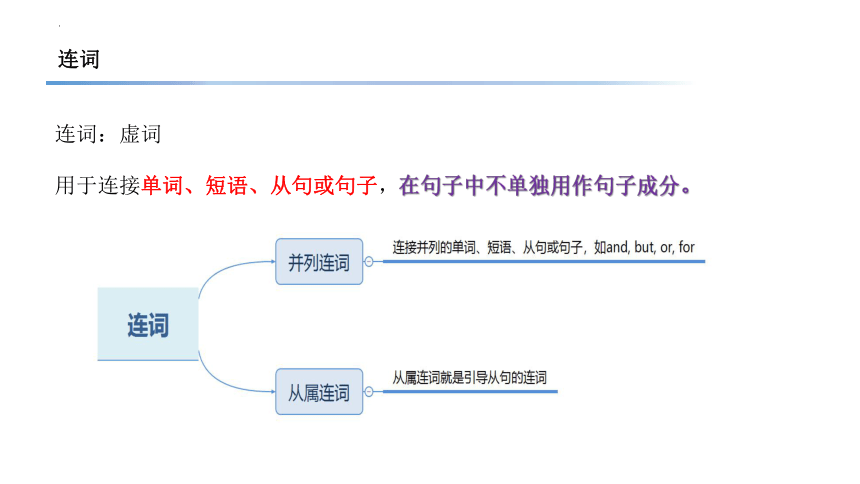 | |
| 格式 | pptx | ||
| 文件大小 | 915.5KB | ||
| 资源类型 | 教案 | ||
| 版本资源 | 通用版 | ||
| 科目 | 英语 | ||
| 更新时间 | 2022-03-02 16:28:53 | ||
图片预览

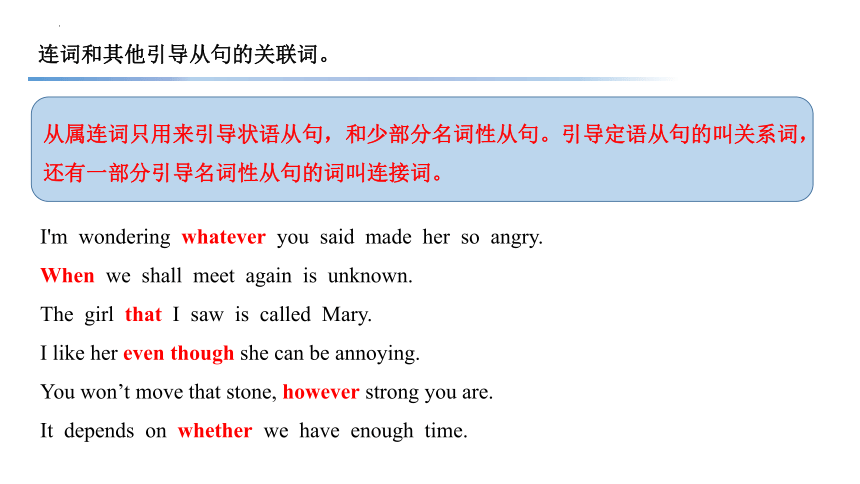
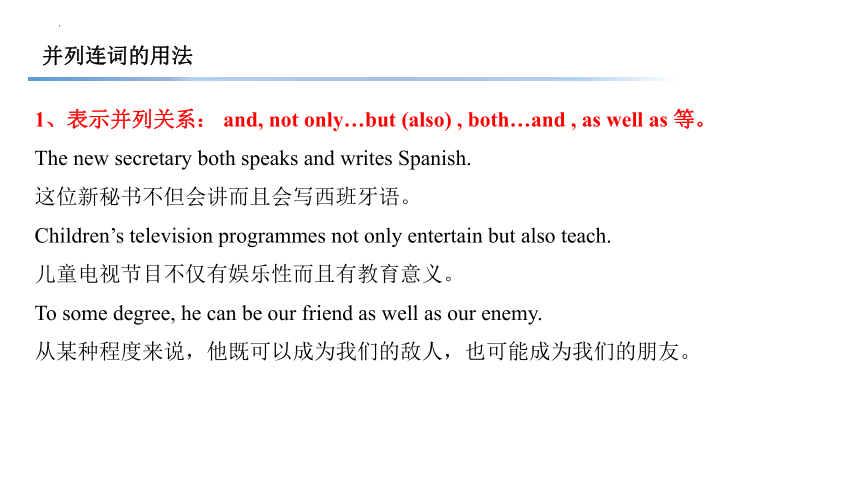
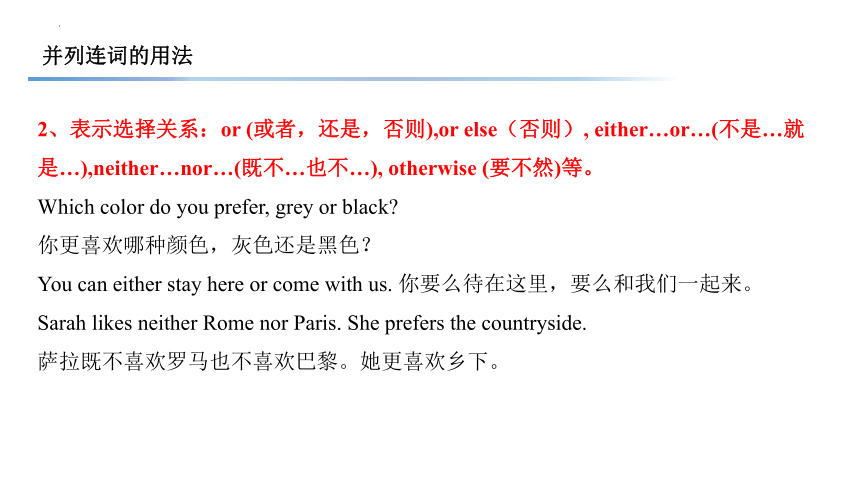
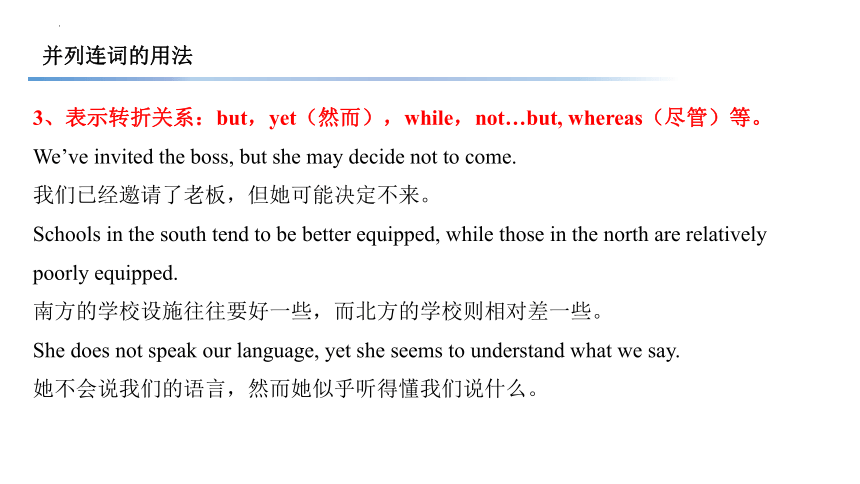
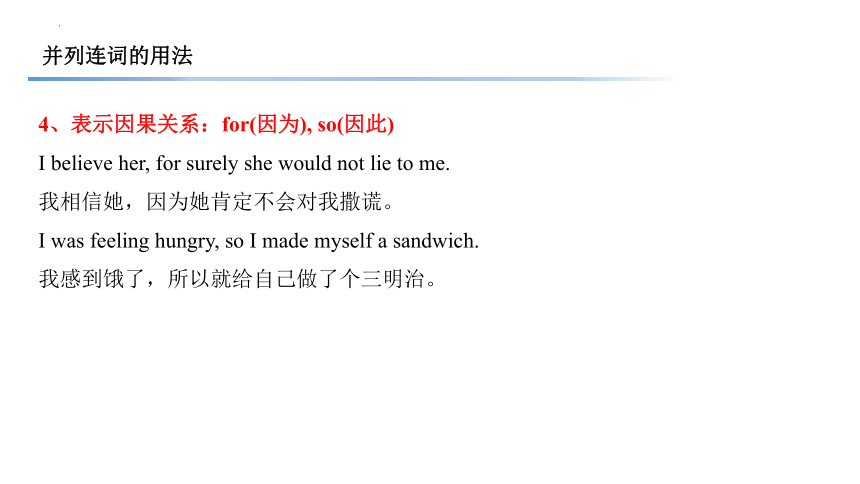
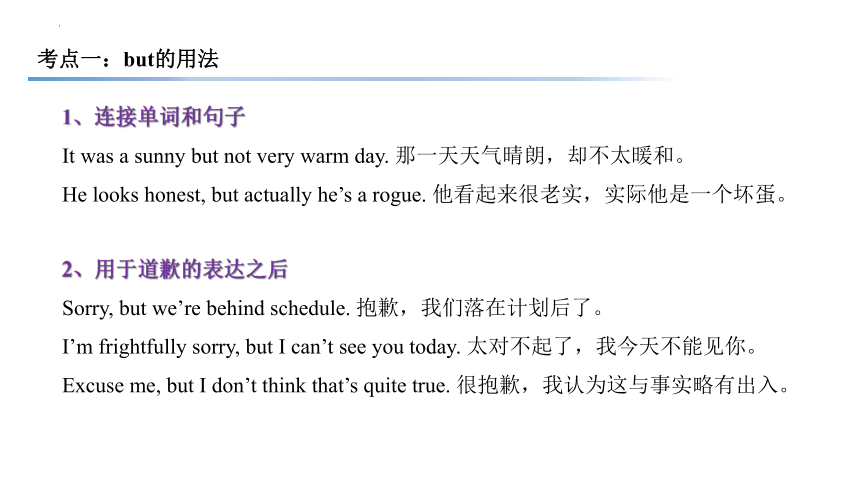

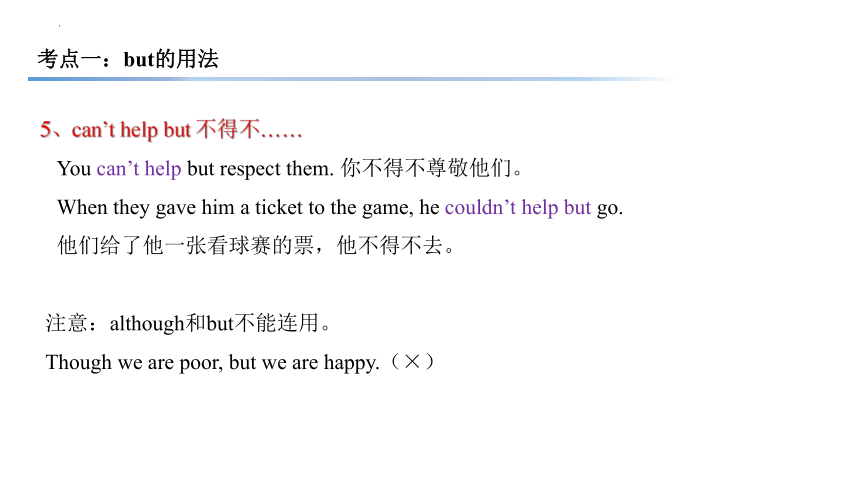
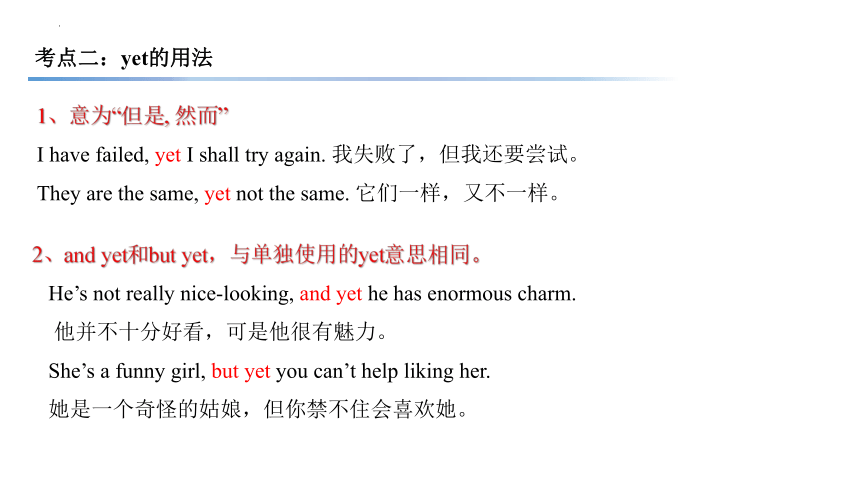

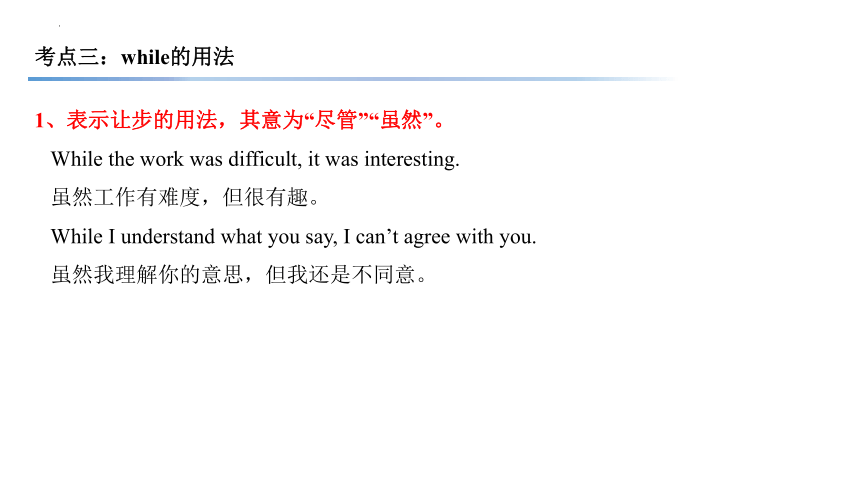
文档简介
(共56张PPT)
连词:虚词
用于连接单词、短语、从句或句子,在句子中不单独用作句子成分。
连词
I'm wondering whatever you said made her so angry.
When we shall meet again is unknown.
The girl that I saw is called Mary.
I like her even though she can be annoying.
You won’t move that stone, however strong you are.
It depends on whether we have enough time.
连词和其他引导从句的关联词。
从属连词只用来引导状语从句,和少部分名词性从句。引导定语从句的叫关系词,还有一部分引导名词性从句的词叫连接词。
并列连词的用法
1、表示并列关系: and, not only…but (also) , both…and , as well as 等。
The new secretary both speaks and writes Spanish.
这位新秘书不但会讲而且会写西班牙语。
Children’s television programmes not only entertain but also teach.
儿童电视节目不仅有娱乐性而且有教育意义。
To some degree, he can be our friend as well as our enemy.
从某种程度来说,他既可以成为我们的敌人,也可能成为我们的朋友。
并列连词的用法
2、表示选择关系:or (或者,还是,否则),or else(否则), either…or…(不是…就是…),neither…nor…(既不…也不…), otherwise (要不然)等。
Which color do you prefer, grey or black
你更喜欢哪种颜色,灰色还是黑色?
You can either stay here or come with us. 你要么待在这里,要么和我们一起来。
Sarah likes neither Rome nor Paris. She prefers the countryside.
萨拉既不喜欢罗马也不喜欢巴黎。她更喜欢乡下。
并列连词的用法
3、表示转折关系:but,yet(然而),while,not…but, whereas(尽管)等。
We’ve invited the boss, but she may decide not to come.
我们已经邀请了老板,但她可能决定不来。
Schools in the south tend to be better equipped, while those in the north are relatively poorly equipped.
南方的学校设施往往要好一些,而北方的学校则相对差一些。
She does not speak our language, yet she seems to understand what we say.
她不会说我们的语言,然而她似乎听得懂我们说什么。
并列连词的用法
4、表示因果关系:for(因为), so(因此)
I believe her, for surely she would not lie to me.
我相信她,因为她肯定不会对我撒谎。
I was feeling hungry, so I made myself a sandwich.
我感到饿了,所以就给自己做了个三明治。
考点一:but的用法
1、连接单词和句子
It was a sunny but not very warm day. 那一天天气晴朗,却不太暖和。
He looks honest, but actually he’s a rogue. 他看起来很老实,实际他是一个坏蛋。
2、用于道歉的表达之后
Sorry, but we’re behind schedule. 抱歉,我们落在计划后了。
I’m frightfully sorry, but I can’t see you today. 太对不起了,我今天不能见你。
Excuse me, but I don’t think that’s quite true. 很抱歉,我认为这与事实略有出入。
3、not…but…,表示“不是……而是……”
Not you but I am to blame. 不是你的错而是我的错。
4、用在某些否定语后,表示“只……”
He eats nothing but hamburgers. 他只吃汉堡包。
She knows no one but you. 她只认识你。
You have nobody but yourself to blame. 只能怪你自己。
No one but me saw her. 只有我看见他
考点一:but的用法
5、can’t help but 不得不……
You can’t help but respect them. 你不得不尊敬他们。
When they gave him a ticket to the game, he couldn’t help but go.
他们给了他一张看球赛的票,他不得不去。
注意:although和but不能连用。
Though we are poor, but we are happy.(×)
考点一:but的用法
考点二:yet的用法
1、意为“但是, 然而”
I have failed, yet I shall try again. 我失败了,但我还要尝试。
They are the same, yet not the same. 它们一样,又不一样。
2、and yet和but yet,与单独使用的yet意思相同。
He’s not really nice-looking, and yet he has enormous charm.
他并不十分好看,可是他很有魅力。
She’s a funny girl, but yet you can’t help liking her.
她是一个奇怪的姑娘,但你禁不住会喜欢她。
考点二:yet的用法
although不能与连词but搭配使用,但是although可以与yet搭配连用
此时的yet可视为副词
Although we are poor, yet we are happy.
尽管我们穷,但我们很快活。
Although we have made some progress, yet we still have a long way to go.
我们虽然取得了些进步,但还是远远不够的。
考点三:while的用法
1、表示让步的用法,其意为“尽管”“虽然”。
While the work was difficult, it was interesting.
虽然工作有难度,但很有趣。
While I understand what you say, I can’t agree with you.
虽然我理解你的意思,但我还是不同意。
考点三:while的用法
2、表示对比的用法,其意为“而”“但”
I went swimming while the others played tennis.
我去游泳,而其余的人则去打网球了。
Air is a fluid but not a liquid, while water is both a fluid and a liquid.
空气是流体不是液体,水是流体也是液体。
考点四:or的用法
1、表示选择,意为“或”“还是”:
Is the radio off or on 无线电关上了还是开着的
Would you prefer tea or coffee 你喜欢茶还是咖啡?
2、表示一种否定的条件,意为“否则”:
Come on, or we’ll be late. 快点,否则我们要迟到了。
Hurry up, or you'll be late for school. 赶快,否则你上学就要迟到了。
3、表示“要不就是”
He must be joking, or else he’s mad. 他一定在说笑话,要不就是疯了。
The book must be here, or else you’ve lost it. 这书一定在这儿,要不就是你丢失了。
4、否定句中代替and
He was not clever or good-looking. 他不聪明,也长得不好看。
考点四:or的用法
“Put on your coat, ______ you will catch a cold!” This is what my mum often says .
A.and B.but C.or D.so
练一练
for作连词,主要表示理由,用于引起分句对前面的话进行解释,常用逗号把它和前面的分句分开。
She was angry, for she didn’t know French. 她生气了,因为她不懂法语。
He must be out, for there is no light in the room. 他准是出去了,因为屋里没有灯。
He shook his head, for he thought differently. 他摇了摇头,因为他有不同想法。
考点五:for的用法
for表示原因时的四个“不能”
1、for引导的从句不能位于它所解释的动词之前
Because it was wet he took a taxi. 因为下雨,他叫了一辆出租车。
2、for引导的从句不能位于not, but或任何连词之后
He stole, not because he wanted the money but because he liked stealing.
他偷东西,并不是因为他想要钱,而是他有这种毛病。(这里不能用for)
3、for引导的从句不能用于回答why引出的问题:
—Why did you do it 你为什么这么做
—I did it because l was angry. 因为我生气才这么做的。
4、for引导的从句不能单单用来复述已讲过的话,而必须包括新的内容:
He spoke in French. She was angry because he had spoken in French.
他讲法语。因为他讲法语,她生气了。
She was angry, for she didn’t know French.
她生气了,因为她不懂法语。
for表示原因时的四个“不能”
考点六:连词so的用法
1、so用作连词,主要用于表结果,意为“所以”:
It’s very cold, so wear a heavy coat. 外边很冷,因此穿一件厚大衣。
The door was locked, so we couldn’t get in. 门上锁了,所以我们进不去。
2、有时可与并列连词and连用,构成习语and so(相当so):
He told me to do it and so I did it. 他叫我那么做,所以我就做了。
He worked hard and so he succeeded. 他勤奋工作,所以他取得了成功。
副词 如此地 so adj/adv so adj a/an 可数名词单数
such such a adj 可数名词单数 such 不可数名词
不能用because…so…:
误:Because he was ill, so he couldn't come
考点七:and 用法
基本义为“和”“又”“而且
Lucy and I go to school five days a week. 我和露西每周上五天学。
2、表示对比或转折,相当于汉语的“而”“但”“却”。
She’s a bank manager and I’m just a road-sweeper.
她是银行经理,而我不过是个扫街的。
I’ve read Tony’s book and I don’t understand it. 我读过托尼的书,但我不懂。
考点七: and 用法
3、用于连接两个相同的词语
(1) 连接两个相同的比较级,表示“越来越……”
The weather is getting colder and colder. 天气越来越冷了。
Your English is getting better and better. 你的英语越来越好了。
Computers are becoming more and more complicated. 计算机变得越来越复杂。
考点七: and 用法
3、用于连接两个相同的词语
(2) 连接两个相同的动词,表示动作的反复或连续。
He coughed and coughed. 他咳个不停。
He tried and tried but without success. 他试了又试却未成功。
4、用于连接两个相同的词语
连接两个相同的名词
考点七: and 用法
①表示“许多”。如:
They talked for hours and hours. 他们谈了很长很长时间。
The road went on for miles and miles. 这条路很长很长。
②强调差别,意为“与……不同”。如:
Don’t worry there are rules and rules. 别担心——规则跟规则不一样。
I like city life but there are cities and cities. 我喜欢城市生活,但城市之间也有差别
5、在come和go以动词原形出现时,用“and+动词原形”表示目的。
I must go and help my mother. 我必须去帮助我母亲。
I’ll come and check the accounts. 我将来清理账目。
注意:如果go和come不是以动词原形出现,而是以过去式、过去分词、现在分词、动名词等方式出现,则其后应不定式表示目的。
I have come to collect my book. 我来取我的书。come-came-come
I’ m thinking of going to look for mushrooms. 我想去采蘑菇。go - went-gone
考点七: and 用法
6、用在祈使句后,表示结果,意为“那么”(暗示一种条件)
Work hard and you’ll pass the examinations
=If you work hard, you’ll pass the examinations
努力吧,你考试会及格的。
Arrive late once more and you’re fired
=If you arrive late once more, you’re fired
再迟到一次,就把你开除。
考点七: and 用法
Give me your email address, ____________ I’11 send you the form
A.or B.and C.but D.nor
Smile to the world, ________ the world will smile back to you.
A.nor B.but C.or D.and
练一练
丛属连词
从属连词连接俩个或俩个以上的句子,从而构成复合句。
按照词形分类,从属连词可以分为:
(1)简单从属连词
(2)复合连词
(3)关联丛属连词
(1)简单从属连词
简单从属连词是由单个单词充当的从属连词:after, although, as, become, before, if, lest, once, since, that, than, though, till, unless, until, when, where, whether, while等。
He started the job soon after he left the university.
他大学毕业后不久就开始做这份工作。
Although/though he studied hard, he failed in the final examination.
尽管努力学习,他还是没有通过期末考试。
Once we arrive, we will give you a phone call.
我们一到,就会给你打电话。
Many things have happened since I last saw him.
自从我上次见到他以来已经发生了很多事情。
考点链接
___________ I went home, my mother was drinking her tea.
When
Because
If
though
(2)复合连词
由俩个或俩个以上的单词构成的从属连词叫做复合从属连词。
except that(除了), so that(因此,结果是), given that(鉴于), in that(因为), in order that, now(that)(既然), on condition that(若是), provided(that),providing(that)(如果),supposing(that)(假如,如果), for fear (that)等。以及as/so far as(只要), as/so long as(只要), as soon as(一……就)等。以及in case, as if, as though, no matter what, no matter who, no matter how, no matter when, no matter where等。
考点链接
Did you catch the early bus this morning
Yes, the bus started to move_________ I got on it.
A. as though
B. so that
C. as soon as
D. as long as
(3)关联丛属连词
由俩个关联词构成的从属连词叫做关联从属连词。
(al)though…yet, as…as, (just)as… so, no sooner…than, not so…as, so …that, such…that, whether…or, the +比较级,the+比较级等。
Listen to your friends’ opinions, even if you might not like them.
听取你朋友的意见,即使你可能不喜欢它们。
The moment Jackie Chan appeared, all the fans looked at him in admiration.
成龙一出现,所有影迷都钦佩的看着他。
介词考点
(一)表示时间的介词
1.at, on, in
at ①表示“在某一时刻、某一时点”
at 5:30 at sunrise 日出时 at lunch 午饭时
②表示“在……岁”用at the age of…
at the age of five.在五岁时
on ①表示“在具体某一天或某天的上、下午
on Monday在星期一 on April 1st在四月一日
②指具体某一天的上、下午、晚上、夜间,一律用on
On the afternoon of May 23.在五月二十三日下午。
in ①泛指在上午,下午,晚上时用in
in the morning/afternoon/evening 在上午/下午/晚上
②表示“在某年、月、季节、世纪”
in September 在九月 in winter 在冬季
in 1999 在1999年 in the 20th century 在20世纪
1.at, on, in
2.for, during, through
(1) for表示“一段时间”,后接与数词连用的时间名词。多与完成时连用。
I’ve been a soldier for 5 years.我入伍已5年了。
She has been ill for several days. 她已经病了几天了。
(2) during表示“在……期间”
He visited many nice places during his stay here.在他逗留期间他参观了许多美丽的地方。
What did you do during the summer vacation 你在暑假做了什么?
(3) through表示“一直……,自始至终”
They worked hard through the winter.整个冬天他们都在努力工作。
She treated me like her brother through these years. 这些年来她始终把我当哥哥对待。
(二)表示“地点、方向”的介词
①in表示“在……里面”
What’s in the box 盒子里是什么?
She put her book in the desk. 她把书放进了书桌。
②outside指“在……外面”
There are many people outside the room.房间外有很多人。
What did your see outside the hall 你在大厅外看见了什么?
③between在……之间(指二者)
There is a hospital between the hotel and the post office.在宾馆与邮局之间有所医院。
The building stands between the park and the small river.
那栋建筑位于公园和小河之间。
④among在……之间(指三者以上)
“There is a thief among you.” The policeman shouted to the crowd.
警察向人群喊道:“你们中间有个小偷!”
He found his place among the crowd. 他在人群中找到了他的位置。
between是指“在两者之间”,而among指“在多个之间”。
(二)表示“地点、方向”的介词
on, above, over, below, under
(1) on在……上面,表面相互接触。
There is an apple on the table. 桌上有一个苹果。
On the top of the hill, there is a flag. 山顶有一面旗子。
(2) above只表示“在……上方或位置高出……”,与below相对。
A plane flew above our heads.一架飞机从我们头上飞过。
The Turners live above us. 特纳一家人住在我们的上面。
(二)表示“地点、方向”的介词
(3) over“在……正上方”,与under相对。
There is a bridge over the river.河上有一座桥。
The picture is hanging over the blackboard. 那张图挂在黑板的正上方。
(4) below在……下方,低于……
There are many flowers below the window.窗下有很多花。
Her skirt reaches just below her knees.她的裙子刚到膝盖下。
(5) under在……正下方
They sat under a big tree, drinking.他们坐在一棵大树下喝酒。
What are you wearing under your coat 你外套里面穿了什么?
(二)表示“地点、方向”的介词
near, by
(1) near在……附近,与far相对
A hospital was built near the railway station.在火车站附近建了一所医院。
My hone is near he school. 我的家离学校很近。
(2) by = beside,靠近,在……旁边,比near距离更近
He just sat by/ beside me in the cinema.在电影院他就坐在我旁边。
He lay down beside the statuary. 他在雕像旁躺下了。
(二)表示“地点、方向”的介词
(1) in front of在……前面
A river flows in front of the house.房子前有一条河
in the front of表示“在……前部”,指里面。
There is a red chair in the front of the room.在房间前半部有把红椅子。
(2) behind在……后面
A high building stands behind the village.村子后面有一高层建筑。
The cat lies behind the door. 猫躺在门后面。
(3) around在……周围,围绕
There are many trees around the villege.村子周围有很多树围绕。
There are flowers around the stage. 舞台周围摆着鲜花。
in front of, behind, around
(1) from从……
The train started from Paris.火车发自巴黎。
She will fly from Beijing to Hongkong. 她将从北京飞往香港。
(2) to到……(目的地)去,向……
He went to Germany last year.他去年去了德国。
They got to the town very late. 他们很晚才到那个镇。
from, to, for, into, out of
(3) for向……,表目的方向
He left for Tianjin on business yesterday.他昨天出差去天津了。
The train for Shanghai has been away. 去往上海的火车已经开走了。
towards, to和for都可表示“向……”,其区别如下:
①towards仅指朝向某个方向,不一定是目的地,而 to和for都是“向目的地”。
②for作“向(目的地)”时,常用于固定搭配中,如:leave for; start for
(4) into进入
Please put the water into the bottle.请把水倒入瓶子里。
The teacher came into the classroom with a smile. 老师微笑着走进了教室。
(5) out of从……出来
A beautiful girl in red went out of the shop.一个穿红衣服的漂亮女孩从商店里走了出来。
They pulled him out of the water. 他们把他从水里拉了出来。
(1) along沿着
He likes to drive along the river.他喜欢沿着河开车。
There are all kinds of beautiful flowers along the road street. 沿街有着各种美丽的花。
(2) across横穿
The little girl is afraid to go across the street.这个小女孩不敢横穿马路。
It’s dangerous to run across the busy road. 跑着穿越繁忙的马路是很危险的。
(3) through穿过
It took us ten minutes to drive through the tunnel.开车穿过这条隧道花了我们10分钟时间。
He pushed his way through the crowd to the platform. 他从人群里挤到了站台。
along, across, through
都表示“在某个地方”
at多指较小的地方,如车站、家等
in多指在“大地方”,如城市、国家、大洲等
at the railway station
in a tiny village
in a small town
at the capital airport
at, in
1. in 表示在某地范围之内。如:
Shanghai is/lies in the east of China. 上海在中国的东部。
2. to 表示在某地范围之外。如:
Japan is/lies to the east of China. 日本位于中国的东面。
3. on 表示与某地相邻或接壤。如:
Mongolia is/lies on the north of China. 蒙古国位于中国北边。
表示方位的介词:in, to, on
1. by用某种方式,多用于交通。take要加定冠词the take the bus 乘坐公共汽车
表示搭乘交通工具时,用by时不用冠词,用in时要用冠词。请比较:
I went there by bus/in a bus. 我是坐公共汽车去的那儿。
2. with表示“用某种工具”。
He broke the window with a stone. 他用石头把玻璃砸坏了。
注意:with表示用某种工具时,必须用冠词或物主代词。
3. on表示“以……方式”,多用于固定词组。
They talked on the telephone. 他们通过电话进行交谈。
She learns English on the radio/on TV. 她通过收音机/电视学英语。
三.表示方式的介词
1、表示工具或手段的介词:by, with, on
表原因或理由的介词:from, of, with
from指“外在的原因”,如受伤、车祸等。
He died from the wound. 他因受伤而致死。
of指“内在的原因”,如病、饿等。
The old man died of hunger. 老人死于饥饿。
with指生理上或情感上的由外界到内心的原因。
Hearing the news, he jumped with joy. 他们听到这个消息,欣喜若狂。
He was shaking with anger. 他气得浑身发抖。
四.表示原因的介词
because of 表示引起结果的直接原因。
He retired last month because of illness/because he ill.
owing to多表示引起某不良后果的原因。
Owing to the rain they could not come. 由于下雨他们没来。
thanks to表示引起某种幸运结果的原因,常译为“幸亏……,多亏……”。
Thanks to John, we won the game. 多亏约翰,我们才赢了这场比赛。
out of表示动机的起因,常译为“出于……”。
He asked the question out of curiosity. 他出于好奇才问了那个问题。
through多表示因局部而影响全局的原因。
The war was lost through bad organization. 战争因组织不周而失败了。
表示“关于”的介词:of, about, on
(1) of仅指“关于”人或事物的存在
He spoke of the film the other day.他前几天提到了这部影片。
He thought of this matter yesterday.他昨天想到了这件事。
(2) about指“关于”某人或某事物的较详细的情况。
It’s a book for children about Africa and its people.
它是一本供儿童阅读的关于非洲和非洲人的书。
Can you tell me something about yourself 你能告诉我一些关于你自己的事情吗?
(3) on是指“关于”学术性的或严肃的,供专门研究用的。
It’s a textbook on the history of China.它是一本有关中国历史的教科书。
五. 表示关于的介词
(1) like像……一样(其实不是)
The little tiger looks like a cat.这只小老虎看起来像只猫。
The mooncakes are like the moon. 月饼像月亮。
(2) as作为,以……身份(其实是)
He was hanged as a spy.他被作为间谍绞死了。
He talk to me as a father.他以父亲的身份跟我谈话。
六.表示比较的介词
like, as
of, from, in
1. of成品仍可看出原料。
This box is made of paper. 这个盒子是纸做的。
2. from成品已看不出原料。
Wine is made from grapes. 葡萄酒是葡萄酿成的。
3. in表示用某种材料或语言。
Please fill in the form in pencil first. 请先用铅笔填写这个表格。
They talk in English. 他们用英语交谈。
注意:in指用材料,不用冠词;而with指用工具,要用冠词。
请比较:draw in pencil/draw with a pencil。
七、表示材料的介词:
against, for
against反对,for支持,互为反义词。如:
Are you for my idea or against it 你赞同还是反对我的想法?
八、表示支持或反对的介词
连词:虚词
用于连接单词、短语、从句或句子,在句子中不单独用作句子成分。
连词
I'm wondering whatever you said made her so angry.
When we shall meet again is unknown.
The girl that I saw is called Mary.
I like her even though she can be annoying.
You won’t move that stone, however strong you are.
It depends on whether we have enough time.
连词和其他引导从句的关联词。
从属连词只用来引导状语从句,和少部分名词性从句。引导定语从句的叫关系词,还有一部分引导名词性从句的词叫连接词。
并列连词的用法
1、表示并列关系: and, not only…but (also) , both…and , as well as 等。
The new secretary both speaks and writes Spanish.
这位新秘书不但会讲而且会写西班牙语。
Children’s television programmes not only entertain but also teach.
儿童电视节目不仅有娱乐性而且有教育意义。
To some degree, he can be our friend as well as our enemy.
从某种程度来说,他既可以成为我们的敌人,也可能成为我们的朋友。
并列连词的用法
2、表示选择关系:or (或者,还是,否则),or else(否则), either…or…(不是…就是…),neither…nor…(既不…也不…), otherwise (要不然)等。
Which color do you prefer, grey or black
你更喜欢哪种颜色,灰色还是黑色?
You can either stay here or come with us. 你要么待在这里,要么和我们一起来。
Sarah likes neither Rome nor Paris. She prefers the countryside.
萨拉既不喜欢罗马也不喜欢巴黎。她更喜欢乡下。
并列连词的用法
3、表示转折关系:but,yet(然而),while,not…but, whereas(尽管)等。
We’ve invited the boss, but she may decide not to come.
我们已经邀请了老板,但她可能决定不来。
Schools in the south tend to be better equipped, while those in the north are relatively poorly equipped.
南方的学校设施往往要好一些,而北方的学校则相对差一些。
She does not speak our language, yet she seems to understand what we say.
她不会说我们的语言,然而她似乎听得懂我们说什么。
并列连词的用法
4、表示因果关系:for(因为), so(因此)
I believe her, for surely she would not lie to me.
我相信她,因为她肯定不会对我撒谎。
I was feeling hungry, so I made myself a sandwich.
我感到饿了,所以就给自己做了个三明治。
考点一:but的用法
1、连接单词和句子
It was a sunny but not very warm day. 那一天天气晴朗,却不太暖和。
He looks honest, but actually he’s a rogue. 他看起来很老实,实际他是一个坏蛋。
2、用于道歉的表达之后
Sorry, but we’re behind schedule. 抱歉,我们落在计划后了。
I’m frightfully sorry, but I can’t see you today. 太对不起了,我今天不能见你。
Excuse me, but I don’t think that’s quite true. 很抱歉,我认为这与事实略有出入。
3、not…but…,表示“不是……而是……”
Not you but I am to blame. 不是你的错而是我的错。
4、用在某些否定语后,表示“只……”
He eats nothing but hamburgers. 他只吃汉堡包。
She knows no one but you. 她只认识你。
You have nobody but yourself to blame. 只能怪你自己。
No one but me saw her. 只有我看见他
考点一:but的用法
5、can’t help but 不得不……
You can’t help but respect them. 你不得不尊敬他们。
When they gave him a ticket to the game, he couldn’t help but go.
他们给了他一张看球赛的票,他不得不去。
注意:although和but不能连用。
Though we are poor, but we are happy.(×)
考点一:but的用法
考点二:yet的用法
1、意为“但是, 然而”
I have failed, yet I shall try again. 我失败了,但我还要尝试。
They are the same, yet not the same. 它们一样,又不一样。
2、and yet和but yet,与单独使用的yet意思相同。
He’s not really nice-looking, and yet he has enormous charm.
他并不十分好看,可是他很有魅力。
She’s a funny girl, but yet you can’t help liking her.
她是一个奇怪的姑娘,但你禁不住会喜欢她。
考点二:yet的用法
although不能与连词but搭配使用,但是although可以与yet搭配连用
此时的yet可视为副词
Although we are poor, yet we are happy.
尽管我们穷,但我们很快活。
Although we have made some progress, yet we still have a long way to go.
我们虽然取得了些进步,但还是远远不够的。
考点三:while的用法
1、表示让步的用法,其意为“尽管”“虽然”。
While the work was difficult, it was interesting.
虽然工作有难度,但很有趣。
While I understand what you say, I can’t agree with you.
虽然我理解你的意思,但我还是不同意。
考点三:while的用法
2、表示对比的用法,其意为“而”“但”
I went swimming while the others played tennis.
我去游泳,而其余的人则去打网球了。
Air is a fluid but not a liquid, while water is both a fluid and a liquid.
空气是流体不是液体,水是流体也是液体。
考点四:or的用法
1、表示选择,意为“或”“还是”:
Is the radio off or on 无线电关上了还是开着的
Would you prefer tea or coffee 你喜欢茶还是咖啡?
2、表示一种否定的条件,意为“否则”:
Come on, or we’ll be late. 快点,否则我们要迟到了。
Hurry up, or you'll be late for school. 赶快,否则你上学就要迟到了。
3、表示“要不就是”
He must be joking, or else he’s mad. 他一定在说笑话,要不就是疯了。
The book must be here, or else you’ve lost it. 这书一定在这儿,要不就是你丢失了。
4、否定句中代替and
He was not clever or good-looking. 他不聪明,也长得不好看。
考点四:or的用法
“Put on your coat, ______ you will catch a cold!” This is what my mum often says .
A.and B.but C.or D.so
练一练
for作连词,主要表示理由,用于引起分句对前面的话进行解释,常用逗号把它和前面的分句分开。
She was angry, for she didn’t know French. 她生气了,因为她不懂法语。
He must be out, for there is no light in the room. 他准是出去了,因为屋里没有灯。
He shook his head, for he thought differently. 他摇了摇头,因为他有不同想法。
考点五:for的用法
for表示原因时的四个“不能”
1、for引导的从句不能位于它所解释的动词之前
Because it was wet he took a taxi. 因为下雨,他叫了一辆出租车。
2、for引导的从句不能位于not, but或任何连词之后
He stole, not because he wanted the money but because he liked stealing.
他偷东西,并不是因为他想要钱,而是他有这种毛病。(这里不能用for)
3、for引导的从句不能用于回答why引出的问题:
—Why did you do it 你为什么这么做
—I did it because l was angry. 因为我生气才这么做的。
4、for引导的从句不能单单用来复述已讲过的话,而必须包括新的内容:
He spoke in French. She was angry because he had spoken in French.
他讲法语。因为他讲法语,她生气了。
She was angry, for she didn’t know French.
她生气了,因为她不懂法语。
for表示原因时的四个“不能”
考点六:连词so的用法
1、so用作连词,主要用于表结果,意为“所以”:
It’s very cold, so wear a heavy coat. 外边很冷,因此穿一件厚大衣。
The door was locked, so we couldn’t get in. 门上锁了,所以我们进不去。
2、有时可与并列连词and连用,构成习语and so(相当so):
He told me to do it and so I did it. 他叫我那么做,所以我就做了。
He worked hard and so he succeeded. 他勤奋工作,所以他取得了成功。
副词 如此地 so adj/adv so adj a/an 可数名词单数
such such a adj 可数名词单数 such 不可数名词
不能用because…so…:
误:Because he was ill, so he couldn't come
考点七:and 用法
基本义为“和”“又”“而且
Lucy and I go to school five days a week. 我和露西每周上五天学。
2、表示对比或转折,相当于汉语的“而”“但”“却”。
She’s a bank manager and I’m just a road-sweeper.
她是银行经理,而我不过是个扫街的。
I’ve read Tony’s book and I don’t understand it. 我读过托尼的书,但我不懂。
考点七: and 用法
3、用于连接两个相同的词语
(1) 连接两个相同的比较级,表示“越来越……”
The weather is getting colder and colder. 天气越来越冷了。
Your English is getting better and better. 你的英语越来越好了。
Computers are becoming more and more complicated. 计算机变得越来越复杂。
考点七: and 用法
3、用于连接两个相同的词语
(2) 连接两个相同的动词,表示动作的反复或连续。
He coughed and coughed. 他咳个不停。
He tried and tried but without success. 他试了又试却未成功。
4、用于连接两个相同的词语
连接两个相同的名词
考点七: and 用法
①表示“许多”。如:
They talked for hours and hours. 他们谈了很长很长时间。
The road went on for miles and miles. 这条路很长很长。
②强调差别,意为“与……不同”。如:
Don’t worry there are rules and rules. 别担心——规则跟规则不一样。
I like city life but there are cities and cities. 我喜欢城市生活,但城市之间也有差别
5、在come和go以动词原形出现时,用“and+动词原形”表示目的。
I must go and help my mother. 我必须去帮助我母亲。
I’ll come and check the accounts. 我将来清理账目。
注意:如果go和come不是以动词原形出现,而是以过去式、过去分词、现在分词、动名词等方式出现,则其后应不定式表示目的。
I have come to collect my book. 我来取我的书。come-came-come
I’ m thinking of going to look for mushrooms. 我想去采蘑菇。go - went-gone
考点七: and 用法
6、用在祈使句后,表示结果,意为“那么”(暗示一种条件)
Work hard and you’ll pass the examinations
=If you work hard, you’ll pass the examinations
努力吧,你考试会及格的。
Arrive late once more and you’re fired
=If you arrive late once more, you’re fired
再迟到一次,就把你开除。
考点七: and 用法
Give me your email address, ____________ I’11 send you the form
A.or B.and C.but D.nor
Smile to the world, ________ the world will smile back to you.
A.nor B.but C.or D.and
练一练
丛属连词
从属连词连接俩个或俩个以上的句子,从而构成复合句。
按照词形分类,从属连词可以分为:
(1)简单从属连词
(2)复合连词
(3)关联丛属连词
(1)简单从属连词
简单从属连词是由单个单词充当的从属连词:after, although, as, become, before, if, lest, once, since, that, than, though, till, unless, until, when, where, whether, while等。
He started the job soon after he left the university.
他大学毕业后不久就开始做这份工作。
Although/though he studied hard, he failed in the final examination.
尽管努力学习,他还是没有通过期末考试。
Once we arrive, we will give you a phone call.
我们一到,就会给你打电话。
Many things have happened since I last saw him.
自从我上次见到他以来已经发生了很多事情。
考点链接
___________ I went home, my mother was drinking her tea.
When
Because
If
though
(2)复合连词
由俩个或俩个以上的单词构成的从属连词叫做复合从属连词。
except that(除了), so that(因此,结果是), given that(鉴于), in that(因为), in order that, now(that)(既然), on condition that(若是), provided(that),providing(that)(如果),supposing(that)(假如,如果), for fear (that)等。以及as/so far as(只要), as/so long as(只要), as soon as(一……就)等。以及in case, as if, as though, no matter what, no matter who, no matter how, no matter when, no matter where等。
考点链接
Did you catch the early bus this morning
Yes, the bus started to move_________ I got on it.
A. as though
B. so that
C. as soon as
D. as long as
(3)关联丛属连词
由俩个关联词构成的从属连词叫做关联从属连词。
(al)though…yet, as…as, (just)as… so, no sooner…than, not so…as, so …that, such…that, whether…or, the +比较级,the+比较级等。
Listen to your friends’ opinions, even if you might not like them.
听取你朋友的意见,即使你可能不喜欢它们。
The moment Jackie Chan appeared, all the fans looked at him in admiration.
成龙一出现,所有影迷都钦佩的看着他。
介词考点
(一)表示时间的介词
1.at, on, in
at ①表示“在某一时刻、某一时点”
at 5:30 at sunrise 日出时 at lunch 午饭时
②表示“在……岁”用at the age of…
at the age of five.在五岁时
on ①表示“在具体某一天或某天的上、下午
on Monday在星期一 on April 1st在四月一日
②指具体某一天的上、下午、晚上、夜间,一律用on
On the afternoon of May 23.在五月二十三日下午。
in ①泛指在上午,下午,晚上时用in
in the morning/afternoon/evening 在上午/下午/晚上
②表示“在某年、月、季节、世纪”
in September 在九月 in winter 在冬季
in 1999 在1999年 in the 20th century 在20世纪
1.at, on, in
2.for, during, through
(1) for表示“一段时间”,后接与数词连用的时间名词。多与完成时连用。
I’ve been a soldier for 5 years.我入伍已5年了。
She has been ill for several days. 她已经病了几天了。
(2) during表示“在……期间”
He visited many nice places during his stay here.在他逗留期间他参观了许多美丽的地方。
What did you do during the summer vacation 你在暑假做了什么?
(3) through表示“一直……,自始至终”
They worked hard through the winter.整个冬天他们都在努力工作。
She treated me like her brother through these years. 这些年来她始终把我当哥哥对待。
(二)表示“地点、方向”的介词
①in表示“在……里面”
What’s in the box 盒子里是什么?
She put her book in the desk. 她把书放进了书桌。
②outside指“在……外面”
There are many people outside the room.房间外有很多人。
What did your see outside the hall 你在大厅外看见了什么?
③between在……之间(指二者)
There is a hospital between the hotel and the post office.在宾馆与邮局之间有所医院。
The building stands between the park and the small river.
那栋建筑位于公园和小河之间。
④among在……之间(指三者以上)
“There is a thief among you.” The policeman shouted to the crowd.
警察向人群喊道:“你们中间有个小偷!”
He found his place among the crowd. 他在人群中找到了他的位置。
between是指“在两者之间”,而among指“在多个之间”。
(二)表示“地点、方向”的介词
on, above, over, below, under
(1) on在……上面,表面相互接触。
There is an apple on the table. 桌上有一个苹果。
On the top of the hill, there is a flag. 山顶有一面旗子。
(2) above只表示“在……上方或位置高出……”,与below相对。
A plane flew above our heads.一架飞机从我们头上飞过。
The Turners live above us. 特纳一家人住在我们的上面。
(二)表示“地点、方向”的介词
(3) over“在……正上方”,与under相对。
There is a bridge over the river.河上有一座桥。
The picture is hanging over the blackboard. 那张图挂在黑板的正上方。
(4) below在……下方,低于……
There are many flowers below the window.窗下有很多花。
Her skirt reaches just below her knees.她的裙子刚到膝盖下。
(5) under在……正下方
They sat under a big tree, drinking.他们坐在一棵大树下喝酒。
What are you wearing under your coat 你外套里面穿了什么?
(二)表示“地点、方向”的介词
near, by
(1) near在……附近,与far相对
A hospital was built near the railway station.在火车站附近建了一所医院。
My hone is near he school. 我的家离学校很近。
(2) by = beside,靠近,在……旁边,比near距离更近
He just sat by/ beside me in the cinema.在电影院他就坐在我旁边。
He lay down beside the statuary. 他在雕像旁躺下了。
(二)表示“地点、方向”的介词
(1) in front of在……前面
A river flows in front of the house.房子前有一条河
in the front of表示“在……前部”,指里面。
There is a red chair in the front of the room.在房间前半部有把红椅子。
(2) behind在……后面
A high building stands behind the village.村子后面有一高层建筑。
The cat lies behind the door. 猫躺在门后面。
(3) around在……周围,围绕
There are many trees around the villege.村子周围有很多树围绕。
There are flowers around the stage. 舞台周围摆着鲜花。
in front of, behind, around
(1) from从……
The train started from Paris.火车发自巴黎。
She will fly from Beijing to Hongkong. 她将从北京飞往香港。
(2) to到……(目的地)去,向……
He went to Germany last year.他去年去了德国。
They got to the town very late. 他们很晚才到那个镇。
from, to, for, into, out of
(3) for向……,表目的方向
He left for Tianjin on business yesterday.他昨天出差去天津了。
The train for Shanghai has been away. 去往上海的火车已经开走了。
towards, to和for都可表示“向……”,其区别如下:
①towards仅指朝向某个方向,不一定是目的地,而 to和for都是“向目的地”。
②for作“向(目的地)”时,常用于固定搭配中,如:leave for; start for
(4) into进入
Please put the water into the bottle.请把水倒入瓶子里。
The teacher came into the classroom with a smile. 老师微笑着走进了教室。
(5) out of从……出来
A beautiful girl in red went out of the shop.一个穿红衣服的漂亮女孩从商店里走了出来。
They pulled him out of the water. 他们把他从水里拉了出来。
(1) along沿着
He likes to drive along the river.他喜欢沿着河开车。
There are all kinds of beautiful flowers along the road street. 沿街有着各种美丽的花。
(2) across横穿
The little girl is afraid to go across the street.这个小女孩不敢横穿马路。
It’s dangerous to run across the busy road. 跑着穿越繁忙的马路是很危险的。
(3) through穿过
It took us ten minutes to drive through the tunnel.开车穿过这条隧道花了我们10分钟时间。
He pushed his way through the crowd to the platform. 他从人群里挤到了站台。
along, across, through
都表示“在某个地方”
at多指较小的地方,如车站、家等
in多指在“大地方”,如城市、国家、大洲等
at the railway station
in a tiny village
in a small town
at the capital airport
at, in
1. in 表示在某地范围之内。如:
Shanghai is/lies in the east of China. 上海在中国的东部。
2. to 表示在某地范围之外。如:
Japan is/lies to the east of China. 日本位于中国的东面。
3. on 表示与某地相邻或接壤。如:
Mongolia is/lies on the north of China. 蒙古国位于中国北边。
表示方位的介词:in, to, on
1. by用某种方式,多用于交通。take要加定冠词the take the bus 乘坐公共汽车
表示搭乘交通工具时,用by时不用冠词,用in时要用冠词。请比较:
I went there by bus/in a bus. 我是坐公共汽车去的那儿。
2. with表示“用某种工具”。
He broke the window with a stone. 他用石头把玻璃砸坏了。
注意:with表示用某种工具时,必须用冠词或物主代词。
3. on表示“以……方式”,多用于固定词组。
They talked on the telephone. 他们通过电话进行交谈。
She learns English on the radio/on TV. 她通过收音机/电视学英语。
三.表示方式的介词
1、表示工具或手段的介词:by, with, on
表原因或理由的介词:from, of, with
from指“外在的原因”,如受伤、车祸等。
He died from the wound. 他因受伤而致死。
of指“内在的原因”,如病、饿等。
The old man died of hunger. 老人死于饥饿。
with指生理上或情感上的由外界到内心的原因。
Hearing the news, he jumped with joy. 他们听到这个消息,欣喜若狂。
He was shaking with anger. 他气得浑身发抖。
四.表示原因的介词
because of 表示引起结果的直接原因。
He retired last month because of illness/because he ill.
owing to多表示引起某不良后果的原因。
Owing to the rain they could not come. 由于下雨他们没来。
thanks to表示引起某种幸运结果的原因,常译为“幸亏……,多亏……”。
Thanks to John, we won the game. 多亏约翰,我们才赢了这场比赛。
out of表示动机的起因,常译为“出于……”。
He asked the question out of curiosity. 他出于好奇才问了那个问题。
through多表示因局部而影响全局的原因。
The war was lost through bad organization. 战争因组织不周而失败了。
表示“关于”的介词:of, about, on
(1) of仅指“关于”人或事物的存在
He spoke of the film the other day.他前几天提到了这部影片。
He thought of this matter yesterday.他昨天想到了这件事。
(2) about指“关于”某人或某事物的较详细的情况。
It’s a book for children about Africa and its people.
它是一本供儿童阅读的关于非洲和非洲人的书。
Can you tell me something about yourself 你能告诉我一些关于你自己的事情吗?
(3) on是指“关于”学术性的或严肃的,供专门研究用的。
It’s a textbook on the history of China.它是一本有关中国历史的教科书。
五. 表示关于的介词
(1) like像……一样(其实不是)
The little tiger looks like a cat.这只小老虎看起来像只猫。
The mooncakes are like the moon. 月饼像月亮。
(2) as作为,以……身份(其实是)
He was hanged as a spy.他被作为间谍绞死了。
He talk to me as a father.他以父亲的身份跟我谈话。
六.表示比较的介词
like, as
of, from, in
1. of成品仍可看出原料。
This box is made of paper. 这个盒子是纸做的。
2. from成品已看不出原料。
Wine is made from grapes. 葡萄酒是葡萄酿成的。
3. in表示用某种材料或语言。
Please fill in the form in pencil first. 请先用铅笔填写这个表格。
They talk in English. 他们用英语交谈。
注意:in指用材料,不用冠词;而with指用工具,要用冠词。
请比较:draw in pencil/draw with a pencil。
七、表示材料的介词:
against, for
against反对,for支持,互为反义词。如:
Are you for my idea or against it 你赞同还是反对我的想法?
八、表示支持或反对的介词
